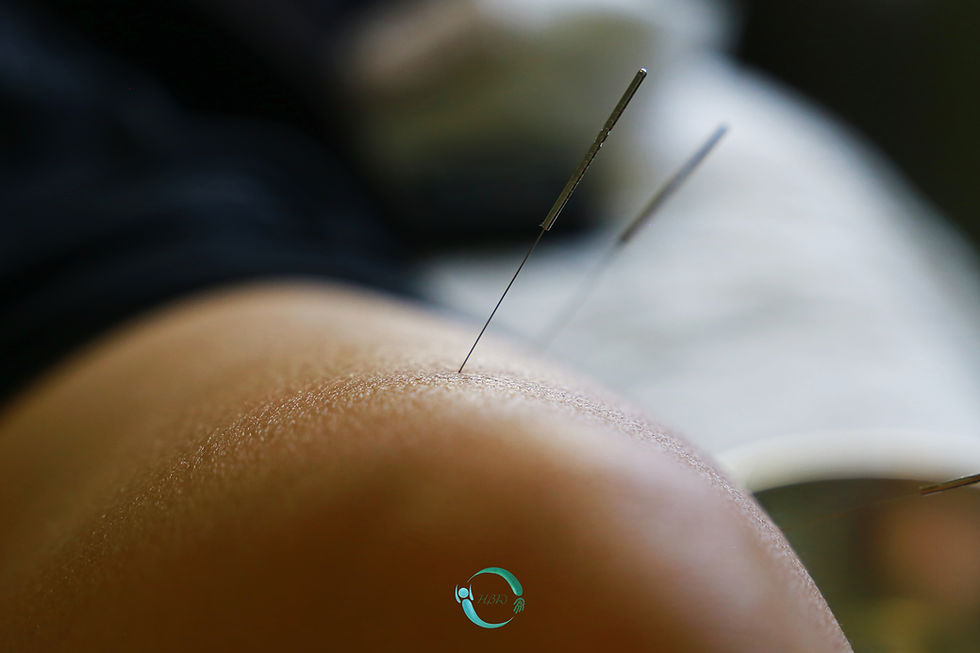4 Benefits of Dry needling therapy
- Harmonize Body Works
- Jun 24, 2022
- 3 min read
Dry needling therapy is getting popular and if you received before you would have felt the benefit but maybe not knowing how exactly this ‘skin penetrating’ treatment worked to your condition. It is still quite unknown technique for many people and I think it is an excellent technique for majority of the people who suffers from myofascial pain, musculoskeletal pain and injury, tendinopathy, and more. We will explain how dry needling works along with 4 major benefits of it and why you should consider adding on to your next appointment.

What is Dry Needling?

Firstly, let’s talk about this mysterious technique itself. Dry Needling therapy is a skilled intervention that uses an acupuncture needle to penetrate the skin and stimulate underlying myofascial trigger points, muscle, and connective tissues which improves neuromusculoskeletal pain and movement impairments. It is a very effective treatment with short treatment time with long lasting result and when it is used correctly, it can be highly beneficial to the conditions that are difficult to treat with manual therapy such as fibromyalgia syndrome, plantar fasciitis, and tendinopathy.
4 Major Benefits

1. Faster release of Myofascial Trigger Points
Myofascial trigger point (AKA Trigger points) is a sensitive spot in a band of skeletal muscle. It can be painful on compression, stretch, overload or contraction of the muscle and which can refer pain into other areas of the body as well. Most of us have this “tender knot” in couple or multiple areas throughout our muscle due to trauma, chronic overuse, degeneration, or an injury.
As a Remedial massage therapist, it is our job to release those during the treatment which can take time, especially if it is develop to be stubborn through years of over work, and that is why releasing trigger point is by dry needling therapy is much efficient. DN therapy mainly targets on releasing these points by inserting the needling into the point and by using various levels depends on the client’s need. Release of myofascial trigger point will increase your physical function and movement with reduce of pain level.

2. Myofascia stimulation-The Whirl Effects
We covered trigger point but what is myofascia? Visualize our body is built with skeletons with muscles and organs, then covered by a large sheet, the skin. Then all the empty spaces in-between the muscles, bones and organs are where myofascia is. It is a connective tissue that “gluing” everything up. Currently we are finding more of our pain and limited movement is more caused by this connective tissue more so from a muscular problem. Dry needling goes in deeper than our skin level and sits inside this connective tissue. And by rotating the needle, it causes whirl effect which is winding of collagen fibres which wraps around the shaft of the needle. This action “stretch” the tissue and simulates the cell to remodeling. Resulting better movement, physical task and reduce of pain level.
3. Healing Tendon tissue

When you have a tendon injury it always the takes much longer to heal, recover and gain back the strength than a muscular injury because tendons are formed different to the muscles. Tendon is a dense, thick, fibrous connective tissue made up of collagen and elastin which doesn’t really have a quick reaction or outcome to manual therapy.
Dry needling can be used perfectly by inserting the needle easily and specifically to the injured tendon without causing more pain. And with the needle stimulating the connective tissue cell, the inflammation and pain level will drop and the tendon will heal and recover faster without further damage.

4. Treating an Acute injury
Most of the time when you have an injury you get told to rest and put an ice pack. Then wait a certain amount of time when the inflammation is past, you’re ready to receive a treatment for the injury. With dry needling therapy you can get an improvement even when there’s still mild inflamed on site. For example, if you have a ankle sprain; ‘rolled ankle’ and a manual therapy wouldn’t help the injury due to the inflammation and the high sensitivity of the area. Dry needling therapy is a perfect treatment if you can handle the needles. Light level of dose can be inserted to the area and you can get great result of reducing inflammation and pain and also faster recovery.
Lastly, as much as dry needling therapy helps most of the people, there are still contraindications and who aren’t suitable for the dry needling therapy. Always speak to the therapist of your interest and after a consultation the therapist should be able to corporate into the treatment.

Written by Seonkyo Kim; Dip RMT





Comments